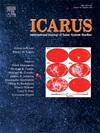The bulk composition and initial size of Mercury
IF 2.5
2区 物理与天体物理
Q2 ASTRONOMY & ASTROPHYSICS
引用次数: 0
Abstract
Enstatite chondrites are often used as models for the bulk composition of Mercury because they have similarly low oxygen fugacities. However, e-chondrites are too Si-rich to explain the observed composition of Mercury's lavas. Here we explore a model in which an initially enstatite chondrite-like Mercurian silicate magma ocean loses Si to the large Fe core during early differentiation. We define a Mercury Fractionation Line (MFL) based on average basaltic geochemical terrane compositions and assume Mercury's bulk silicate composition must fall along this line. We estimate that 26.5–36.7 ± 7.5 % (1σ) Si must be lost from an initial mantle to bring the e-chondrite compositions up to the MFL. Assuming that the Si is partitioned into the core, this implies a core Si content of 2.8–3.9 ± 0.8 wt% and an oxygen fugacity of IW–4.5 ± 1.0. We also show that a model where Mercury was initially ∼2 times larger is consistent with more reducing oxygen fugacities (IW–5.0 ± 1.0) and a higher core Si content (∼15 wt%). This estimated initial Mercury size is also consistent with predictions from dynamical simulations. We consider how Si partitioning into the core affects the δ30Si composition of the mantle. Though uncertainties are large, we show that as the initial radius of Mercury increases, δ30Si decreases, trending towards the δ30Si composition of enstatite chondrites. Our calculations do not constrain the mechanism by which Mercury's mantle may have been lost. However, if they are correct, they imply that the mantle loss must have happened after core formation.
水星的体积组成和初始大小
顽辉石球粒陨石经常被用来作为水星整体组成的模型,因为它们具有类似的低氧逸度。然而,电子球粒陨石的硅含量太高,无法解释观测到的水星熔岩的组成。在这里,我们探索了一个模型,其中一个最初的顽辉石球粒状汞硅酸盐岩浆海洋在早期分化过程中失去了Si到大铁核。我们根据平均玄武岩地球化学成分定义了一条汞分馏线(MFL),并假设水星的总体硅酸盐成分一定落在这条线上。我们估计,要使e-球粒陨石组成上升到MFL,必须从初始地幔中损失26.5-36.7±7.5% (1σ) Si。假设Si分布在岩心中,这意味着岩心Si含量为2.8-3.9±0.8 wt%,氧逸度为IW-4.5±1.0。我们还表明,汞最初大~ 2倍的模型与更多的还原性氧逸度(IW-5.0±1.0)和更高的核心Si含量(~ 15 wt%)相一致。这个估计的初始水星大小也与动力学模拟的预测一致。我们考虑了Si在地核中的分配如何影响地幔的δ30Si组成。虽然不确定性很大,但我们发现随着水星初始半径的增加,δ30Si减小,趋向于顽辉石球粒陨石的δ30Si组成。我们的计算并没有限制水星地幔可能丢失的机制。然而,如果它们是正确的,它们就意味着地幔的损失一定发生在地核形成之后。
本文章由计算机程序翻译,如有差异,请以英文原文为准。
求助全文
约1分钟内获得全文
求助全文
来源期刊

Icarus
地学天文-天文与天体物理
CiteScore
6.30
自引率
18.80%
发文量
356
审稿时长
2-4 weeks
期刊介绍:
Icarus is devoted to the publication of original contributions in the field of Solar System studies. Manuscripts reporting the results of new research - observational, experimental, or theoretical - concerning the astronomy, geology, meteorology, physics, chemistry, biology, and other scientific aspects of our Solar System or extrasolar systems are welcome. The journal generally does not publish papers devoted exclusively to the Sun, the Earth, celestial mechanics, meteoritics, or astrophysics. Icarus does not publish papers that provide "improved" versions of Bode''s law, or other numerical relations, without a sound physical basis. Icarus does not publish meeting announcements or general notices. Reviews, historical papers, and manuscripts describing spacecraft instrumentation may be considered, but only with prior approval of the editor. An entire issue of the journal is occasionally devoted to a single subject, usually arising from a conference on the same topic. The language of publication is English. American or British usage is accepted, but not a mixture of these.
 求助内容:
求助内容: 应助结果提醒方式:
应助结果提醒方式:


